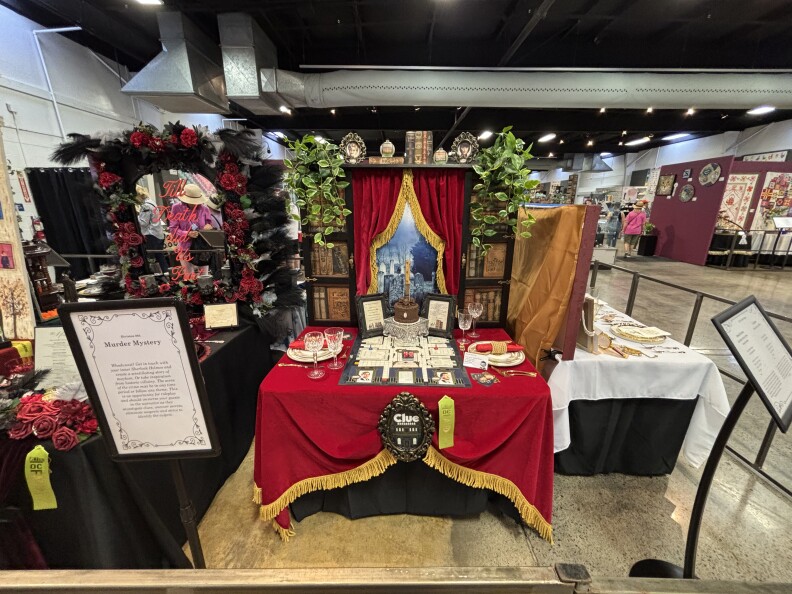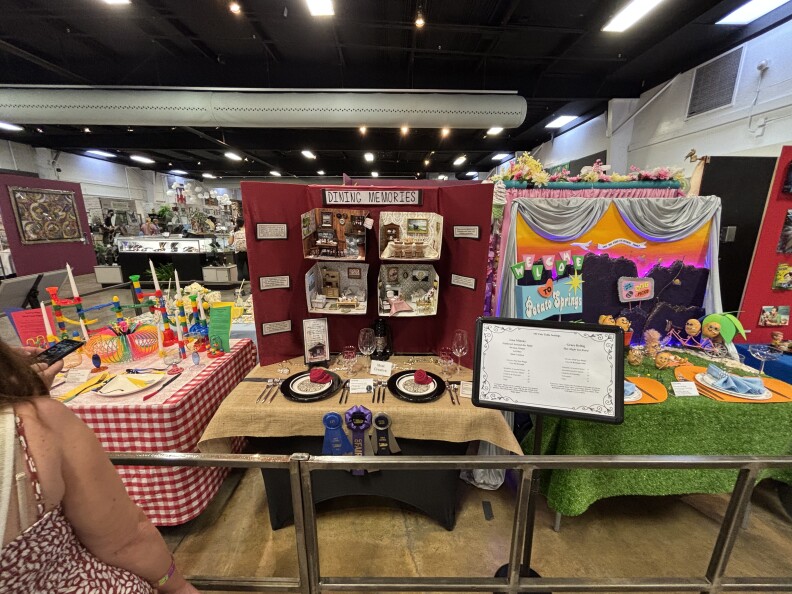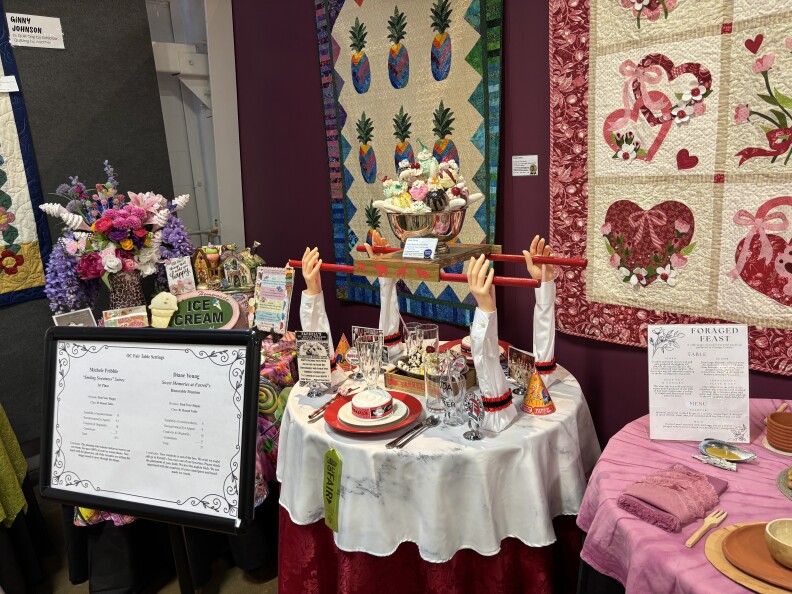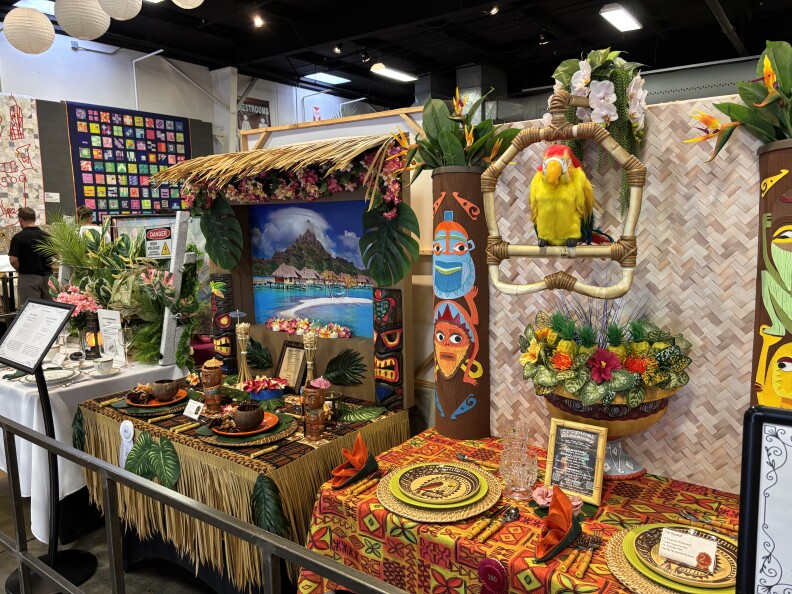From pie eating contests to pig races, county fairs are known for competition. But one contest that’s had a surge in popularity in recent years is one you might not expect: competitive table setting.
A 2021 documentary about the table settings competition at the Orange County Fair called Set! and some highly-viewed TikToks have led to a growth in the number of participants in the contest.
Veteran tablescaper Bonnie Overman recalled seeing fewer than 20 participants in 2019, the first year she participated at the OC Fair. This year, fair officials say there were more than 60 entries — including first-timers like YouTubers Grace Helbig and Mamrie Hart and Emmy-winning production designer James Connelly, who documented their respective tablescaping journeys on social media.
What is competitive table setting?
Some of the table setting entries on opening day of the 2025 OC Fair.
Also called tablescaping (a term that was popularized by Food Network host Sandra Lee in the 2000s), table setting contests don’t have anything to do with how fast you can set a table or even involve any real food or drinks.
They’re contests where participants choose from a theme — this year’s Orange County Fair competition offered “Murder Mystery,” “Tropical Paradise,” “Steampunk,” “A Table For the Gods,” and “Find Your Happy” as options — make up a menu tied to the theme, and then decorate a mini-sized table with place settings that must match the menu (List a salad, but no salad fork? That’s points off).
Listen: Antonia Cereijido went to the OC Fair to find out what it takes to win
No basic table settings need apply.
How do you win?
First off, there’s a lot of work involved to make a display that will match up to the competition.
As Overman put it, “ I never see any tables where people are just throwing stuff together. This is building, construction, sewing, planning.”

Bonnie Overman’s Clue-themed entry into the “Murder Mystery” category.
At the Orange County Fair, themes are released about six months in advance. Then the weekend before the fair, participants get four hours to set up their displays.
That’s when the judges step in. This year there were four judges evaluating the entries on these equally-weighted criteria:
- Suitability for occasion and theme (25%)
- Decorativeness/eye-appeal (25%)
- Creativity and originality (25%)
- Correctness (25%)
There are also some additional rules laid out in the competition guide, like a height limit (6.5 feet), and bans on the use of any real food or disposable tableware.
And the rules are strict!
Lisa Minsky, who won “Best of Division” and “Most Creative” this year for her entry into the “Find Your Happy” category, recalled being docked points the first time she entered the competition in 2007.

Lisa Minsky’s award-winning entry featured miniatures showing some of her happiest dining memories.
Minsky included a champagne bottle in her display that the judges determined violated the “no real food” rule. While she had poured the champagne out and put the cork and foil back on to make it appear unopened, she said the judges “didn’t know that, cause I did that so well. So I was marked down for that.”
It’s not easy being a judge, either.
Annie Morgan, a chef who has been judging the table setting competition for two years, said the opening day of the fair is stressful for her, because that’s when participants can see if they’ve won.

An table setting competition entry called “Sweet Memories at Farrell’s” sports an honorable mention ribbon.
She likened judging the displays to serving on a jury in a high-profile case: “There are guidelines and the public doesn’t understand the guidelines that the jury has, so they may come out with a verdict that the public can’t understand and will protest against. And it’s the same thing here.”
The scores and judges’ comments are posted next to the table setting displays, and sometimes the participants have complaints.
“If they haven’t won,” Morgan said, “they get upset. And then I’m getting emails that I have to explain myself.”
What do you win?
Awards for first, second, third, Division Winner and Best of Show include a monetary prize ranging from $20 to $150, and then of course there are ribbons associated with each.
Other awards that come with smaller ribbons (and no cash prize) include “Best Use of Color” and “Best Napkin Folds.”
Why do people do it?
“You have those people who just want to be creative,” Morgan said. And then, “you have the people who love competition, and want to, you know, dip their toe into whatever that looks like.”
Minsky, who’s entered the competition four times, added: “ It’s a passion. When you get started, it gets more fun as you go along, you know? ‘Cause you sit back and you go, ‘Oh, I can do this, I can do that.’”
She also likes being able to incorporate what she considers her main hobbies, painting and miniatures, into her designs.

Table setting entries in the “Tropical Paradise” category, including Tim Wyckoff’s on the right.
For Tim Wyckoff, a longtime tablescaper, the initial draw was the thrill of winning.
Wyckoff has been tablescaping for 30 years, since he was a teenager, at the Ventura County Fair.
“I saw that the little tiny table settings that the kids got to do got these giant ribbons, and I’m like, ‘Oh, I want that. I want the giant ribbon,’” he said.
Wyckoff said the hobby also helped him through one of the hardest times of his life.
“ I was almost homeless. I was jobless,” he said. “So it was one of those things of like, I don’t have a lot going for me, I’m not very happy, everything kind of sucks. This makes me happy. Like, let me do this.”
This year, Wyckoff took home second place for his tiki-themed entry that featured an animatronic bird that he programmed to sing along to Hawaiian music. And he said he’s not stopping tablescaping any time soon.
”I don’t ever wanna stop,” he said. “Although it’s getting harder, harder to top myself. I’m like, ‘I built an animatronic. What’s next?’”
How to see it
What: OC Fair, open through Aug. 17
Where: 88 Fair Dr, Costa Mesa
Info: Tickets, hours and instructions can be found here





